Huisheng Wang
Improving Subject-Driven Image Synthesis with Subject-Agnostic Guidance
May 02, 2024



Abstract:In subject-driven text-to-image synthesis, the synthesis process tends to be heavily influenced by the reference images provided by users, often overlooking crucial attributes detailed in the text prompt. In this work, we propose Subject-Agnostic Guidance (SAG), a simple yet effective solution to remedy the problem. We show that through constructing a subject-agnostic condition and applying our proposed dual classifier-free guidance, one could obtain outputs consistent with both the given subject and input text prompts. We validate the efficacy of our approach through both optimization-based and encoder-based methods. Additionally, we demonstrate its applicability in second-order customization methods, where an encoder-based model is fine-tuned with DreamBooth. Our approach is conceptually simple and requires only minimal code modifications, but leads to substantial quality improvements, as evidenced by our evaluations and user studies.
Message-Enhanced DeGroot Model
Feb 29, 2024Abstract:Understanding the impact of messages on agents' opinions over social networks is important. However, to our best knowledge, there has been limited quantitative investigation into this phenomenon in the prior works. To address this gap, this paper proposes the Message-Enhanced DeGroot model. The Bounded Brownian Message model provides a quantitative description of the message evolution, jointly considering temporal continuity, randomness, and polarization from mass media theory. The Message-Enhanced DeGroot model, combining the Bounded Brownian Message model with the traditional DeGroot model, quantitatively describes the evolution of agents' opinions under the influence of messages. We theoretically study the probability distribution and statistics of the messages and agents' opinions and quantitatively analyze the impact of messages on opinions. We also conduct simulations to validate our analyses.
VideoPrism: A Foundational Visual Encoder for Video Understanding
Feb 20, 2024
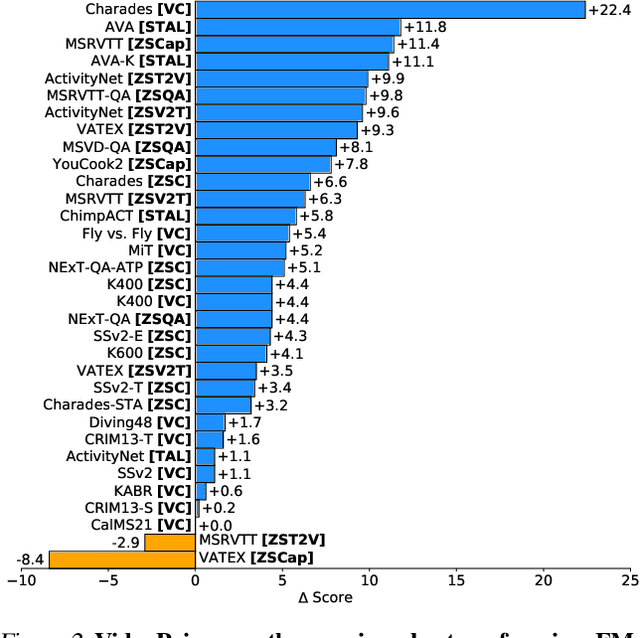

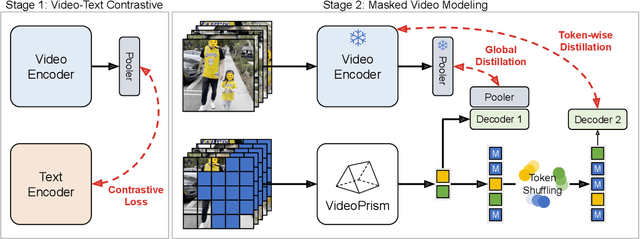
Abstract:We introduce VideoPrism, a general-purpose video encoder that tackles diverse video understanding tasks with a single frozen model. We pretrain VideoPrism on a heterogeneous corpus containing 36M high-quality video-caption pairs and 582M video clips with noisy parallel text (e.g., ASR transcripts). The pretraining approach improves upon masked autoencoding by global-local distillation of semantic video embeddings and a token shuffling scheme, enabling VideoPrism to focus primarily on the video modality while leveraging the invaluable text associated with videos. We extensively test VideoPrism on four broad groups of video understanding tasks, from web video question answering to CV for science, achieving state-of-the-art performance on 30 out of 33 video understanding benchmarks.
VideoPoet: A Large Language Model for Zero-Shot Video Generation
Dec 21, 2023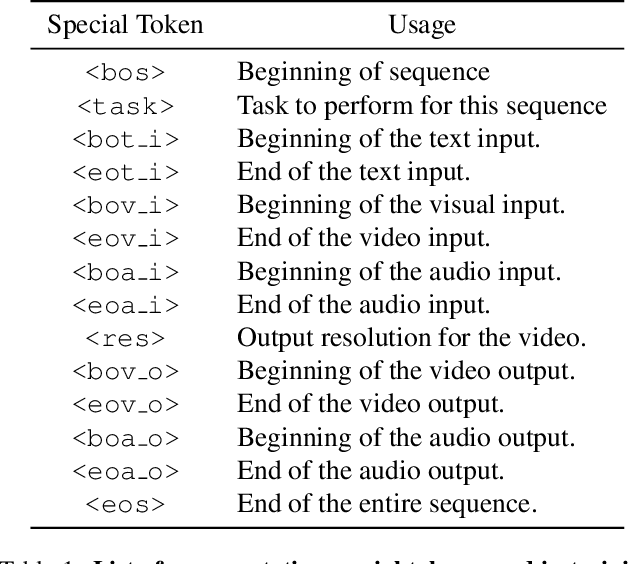



Abstract:We present VideoPoet, a language model capable of synthesizing high-quality video, with matching audio, from a large variety of conditioning signals. VideoPoet employs a decoder-only transformer architecture that processes multimodal inputs -- including images, videos, text, and audio. The training protocol follows that of Large Language Models (LLMs), consisting of two stages: pretraining and task-specific adaptation. During pretraining, VideoPoet incorporates a mixture of multimodal generative objectives within an autoregressive Transformer framework. The pretrained LLM serves as a foundation that can be adapted for a range of video generation tasks. We present empirical results demonstrating the model's state-of-the-art capabilities in zero-shot video generation, specifically highlighting VideoPoet's ability to generate high-fidelity motions. Project page: http://sites.research.google/videopoet/
PolyMaX: General Dense Prediction with Mask Transformer
Nov 09, 2023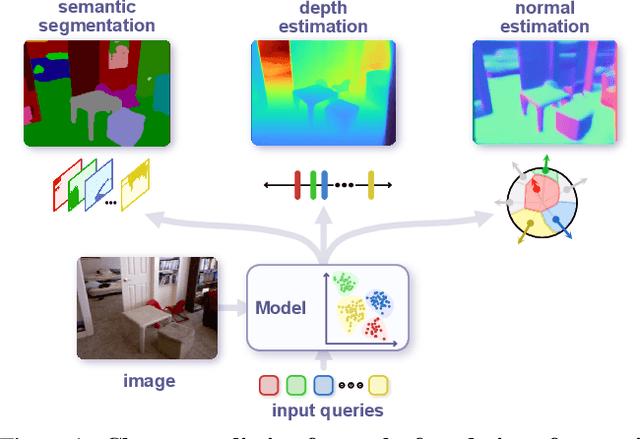


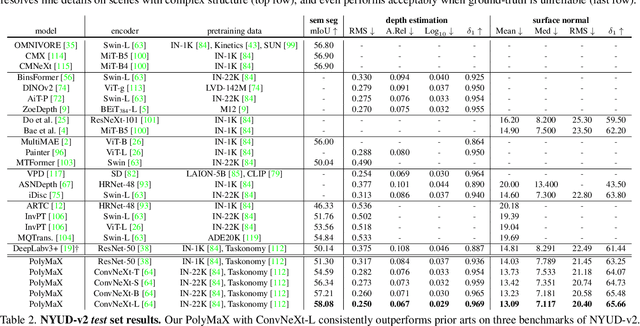
Abstract:Dense prediction tasks, such as semantic segmentation, depth estimation, and surface normal prediction, can be easily formulated as per-pixel classification (discrete outputs) or regression (continuous outputs). This per-pixel prediction paradigm has remained popular due to the prevalence of fully convolutional networks. However, on the recent frontier of segmentation task, the community has been witnessing a shift of paradigm from per-pixel prediction to cluster-prediction with the emergence of transformer architectures, particularly the mask transformers, which directly predicts a label for a mask instead of a pixel. Despite this shift, methods based on the per-pixel prediction paradigm still dominate the benchmarks on the other dense prediction tasks that require continuous outputs, such as depth estimation and surface normal prediction. Motivated by the success of DORN and AdaBins in depth estimation, achieved by discretizing the continuous output space, we propose to generalize the cluster-prediction based method to general dense prediction tasks. This allows us to unify dense prediction tasks with the mask transformer framework. Remarkably, the resulting model PolyMaX demonstrates state-of-the-art performance on three benchmarks of NYUD-v2 dataset. We hope our simple yet effective design can inspire more research on exploiting mask transformers for more dense prediction tasks. Code and model will be made available.
SANPO: A Scene Understanding, Accessibility, Navigation, Pathfinding, Obstacle Avoidance Dataset
Sep 21, 2023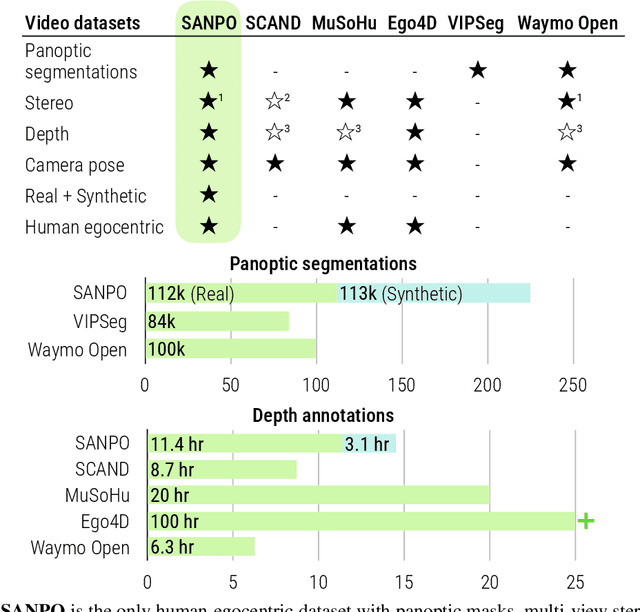

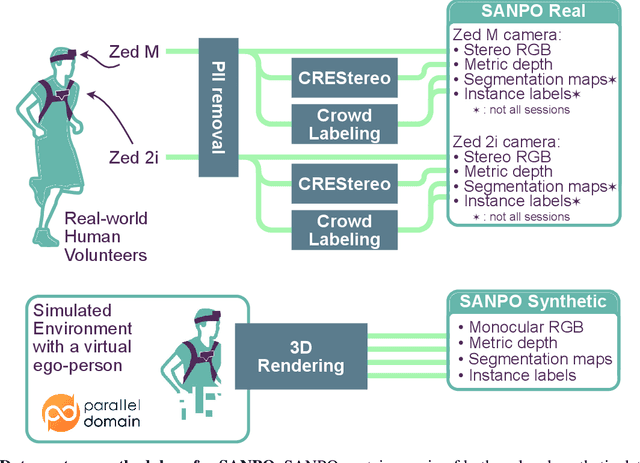

Abstract:We introduce SANPO, a large-scale egocentric video dataset focused on dense prediction in outdoor environments. It contains stereo video sessions collected across diverse outdoor environments, as well as rendered synthetic video sessions. (Synthetic data was provided by Parallel Domain.) All sessions have (dense) depth and odometry labels. All synthetic sessions and a subset of real sessions have temporally consistent dense panoptic segmentation labels. To our knowledge, this is the first human egocentric video dataset with both large scale dense panoptic segmentation and depth annotations. In addition to the dataset we also provide zero-shot baselines and SANPO benchmarks for future research. We hope that the challenging nature of SANPO will help advance the state-of-the-art in video segmentation, depth estimation, multi-task visual modeling, and synthetic-to-real domain adaptation, while enabling human navigation systems. SANPO is available here: https://google-research-datasets.github.io/sanpo_dataset/
Opinion Dynamics in Two-Step Process: Message Sources, Opinion Leaders and Normal Agents
Sep 11, 2023



Abstract:According to mass media theory, the dissemination of messages and the evolution of opinions in social networks follow a two-step process. First, opinion leaders receive the message from the message sources, and then they transmit their opinions to normal agents. However, most opinion models only consider the evolution of opinions within a single network, which fails to capture the two-step process accurately. To address this limitation, we propose a unified framework called the Two-Step Model, which analyzes the communication process among message sources, opinion leaders, and normal agents. In this study, we examine the steady-state opinions and stability of the Two-Step Model. Our findings reveal that several factors, such as message distribution, initial opinion, level of stubbornness, and preference coefficient, influence the sample mean and variance of steady-state opinions. Notably, normal agents' opinions tend to be influenced by opinion leaders in the two-step process. We also conduct numerical and social experiments to validate the accuracy of the Two-Step Model, which outperforms other models on average. Our results provide valuable insights into the factors that shape social opinions and can guide the development of effective strategies for opinion guidance in social networks.
VideoGLUE: Video General Understanding Evaluation of Foundation Models
Jul 06, 2023



Abstract:We evaluate existing foundation models video understanding capabilities using a carefully designed experiment protocol consisting of three hallmark tasks (action recognition, temporal localization, and spatiotemporal localization), eight datasets well received by the community, and four adaptation methods tailoring a foundation model (FM) for a downstream task. Moreover, we propose a scalar VideoGLUE score (VGS) to measure an FMs efficacy and efficiency when adapting to general video understanding tasks. Our main findings are as follows. First, task-specialized models significantly outperform the six FMs studied in this work, in sharp contrast to what FMs have achieved in natural language and image understanding. Second,video-native FMs, whose pretraining data contains the video modality, are generally better than image-native FMs in classifying motion-rich videos, localizing actions in time, and understanding a video of more than one action. Third, the video-native FMs can perform well on video tasks under light adaptations to downstream tasks(e.g., freezing the FM backbones), while image-native FMs win in full end-to-end finetuning. The first two observations reveal the need and tremendous opportunities to conduct research on video-focused FMs, and the last confirms that both tasks and adaptation methods matter when it comes to the evaluation of FMs.
Alternating Gradient Descent and Mixture-of-Experts for Integrated Multimodal Perception
May 10, 2023



Abstract:We present Integrated Multimodal Perception (IMP), a simple and scalable multimodal multi-task training and modeling approach. IMP integrates multimodal inputs including image, video, text, and audio into a single Transformer encoder with minimal modality-specific components. IMP makes use of a novel design that combines Alternating Gradient Descent (AGD) and Mixture-of-Experts (MoE) for efficient model \& task scaling. We conduct extensive empirical studies about IMP and reveal the following key insights: 1) performing gradient descent updates by alternating on diverse heterogeneous modalities, loss functions, and tasks, while also varying input resolutions, efficiently improves multimodal understanding. 2) model sparsification with MoE on a single modality-agnostic encoder substantially improves the performance, outperforming dense models that use modality-specific encoders or additional fusion layers and greatly mitigating the conflicts between modalities. IMP achieves competitive performance on a wide range of downstream tasks including image classification, video classification, image-text, and video-text retrieval. Most notably, we train a sparse IMP-MoE-L focusing on video tasks that achieves new state-of-the-art in zero-shot video classification. Our model achieves 77.0% on Kinetics-400, 76.8% on Kinetics-600, and 76.8% on Kinetics-700 zero-shot classification accuracy, improving the previous state-of-the-art by +5%, +6.7%, and +5.8%, respectively, while using only 15% of their total training computational cost.
Identity Encoder for Personalized Diffusion
Apr 14, 2023Abstract:Many applications can benefit from personalized image generation models, including image enhancement, video conferences, just to name a few. Existing works achieved personalization by fine-tuning one model for each person. While being successful, this approach incurs additional computation and storage overhead for each new identity. Furthermore, it usually expects tens or hundreds of examples per identity to achieve the best performance. To overcome these challenges, we propose an encoder-based approach for personalization. We learn an identity encoder which can extract an identity representation from a set of reference images of a subject, together with a diffusion generator that can generate new images of the subject conditioned on the identity representation. Once being trained, the model can be used to generate images of arbitrary identities given a few examples even if the model hasn't been trained on the identity. Our approach greatly reduces the overhead for personalized image generation and is more applicable in many potential applications. Empirical results show that our approach consistently outperforms existing fine-tuning based approach in both image generation and reconstruction, and the outputs is preferred by users more than 95% of the time compared with the best performing baseline.
 Add to Chrome
Add to Chrome Add to Firefox
Add to Firefox Add to Edge
Add to Edge